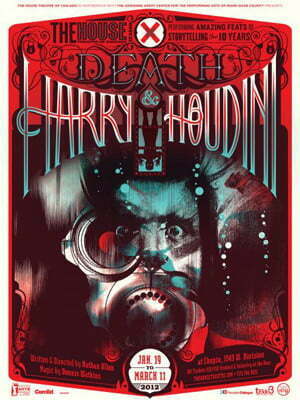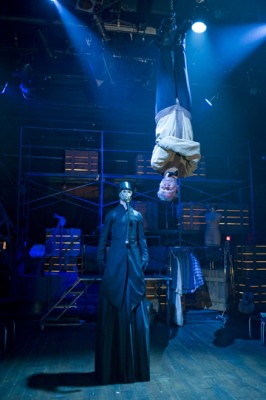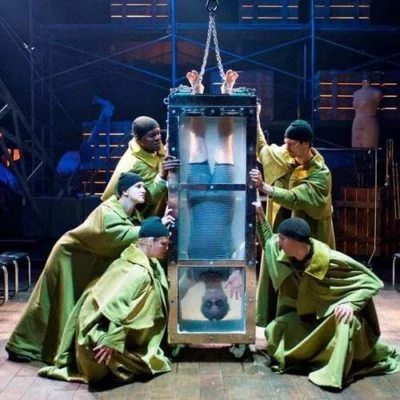Death and Harry Houdini
Written and Directed By Nathan Allen
Magic by Dennis Watkins
Produced by The House Theatre of Chicago
At Chopin Theatre
Death is dead. Long live Death!
The best magic isn’t just about spectacle, it’s about the story. The illusions become metaphors for our shared human experience, and the mystery of existence. That lesson is not lost in The House Theatre of Chicago’s revival production of Death and Harry Houdini, the show that put them on the map ten years ago. It’s a true wonder of Chicago theatre—mingling vaudeville with magic, prose with poetry. Illusionist and escape artist extrardinaire Harry Houdini’s struggle with death’s reality, which looks like a danse macabre, becomes the launching point for a spectacle of sublime proportions.
 As written and directed by Nathan Allen, the production wisely avoids becoming a biopic. Choosing instead to briskly touch at Houdini’s major life events where he brushed with death (an imposing, wordless visage that escorts his victims off stage with a gentlemanly tip of his hat). It begins with his father’s passing, and his vow to become a master of death. Under the tutelage of carnival magician Dr. Lynn, Houdini (Dennis Watkins) learns not just the craft of the stage and illusion, but that death is not the end of life, “just the absence of.” He meets his lovely wife and assistant Bess (Carolyn Defrin), works with his craftsman brother Theo (Shawn Pfautsch) and cares for his ailing mother (Marika Mashburn). All the while his skill and fame (and distance to those around him) grows exponentially, but he continues to goad death at every turn with increasingly daring stunts that bring him to the brink just so he can thumb his nose at it. It seems he has a death wish, but what he really has is a life wish.
As written and directed by Nathan Allen, the production wisely avoids becoming a biopic. Choosing instead to briskly touch at Houdini’s major life events where he brushed with death (an imposing, wordless visage that escorts his victims off stage with a gentlemanly tip of his hat). It begins with his father’s passing, and his vow to become a master of death. Under the tutelage of carnival magician Dr. Lynn, Houdini (Dennis Watkins) learns not just the craft of the stage and illusion, but that death is not the end of life, “just the absence of.” He meets his lovely wife and assistant Bess (Carolyn Defrin), works with his craftsman brother Theo (Shawn Pfautsch) and cares for his ailing mother (Marika Mashburn). All the while his skill and fame (and distance to those around him) grows exponentially, but he continues to goad death at every turn with increasingly daring stunts that bring him to the brink just so he can thumb his nose at it. It seems he has a death wish, but what he really has is a life wish.
The production moves deftly between ballads, a cappella, video, humor, pathos, and of course, magic with the supreme verve of its cast. They’re having fun and it’s infectious. It’d be a shame for anyone to reveal what the tricks are just as learning how the trick works takes away some of the fun. It behooves anyone, however, to note the fearlessness of Watkins when he recreates Houdini’s most famous escape: the Chinese Water Torture Cell. It’s mesmerizing, and one wonders at not only his ability to look like Houdini, but to bring what one imagines is the same magnetic presence to the stage.
While anyone can (and should) enjoy this, it is not for the faint of heart. Some of the illusions are genuinely frightening (keep the very young ones and the sensitive at home, or just be prepared to cover their eyes), and the closeness of the staging makes it all the more visceral. The set pieces are sparse but evoke just the right tone, matched only by the costuming which adds yet another level of spectacle.
Houdini’s death was random and ignoble for such a monument of a man. A blow to the stomach as a demonstration of core strength ruptured his appendix, leading to peritonitis. The real Houdini debunked spiritualists who said there was a life after death, but had a special code he would give Bess in a séance just in case. Magicians still gather around the world to try and communicate with Houdini in the afterlife (such was the power of his legacy). As imagined by Allen, Houdini promises Death if there is a way to escape the afterlife, he will find the way out. Exiting Death and Harry Houdini, it’s easy to imagine if anyone could, he would.
Highly Recommended.
Clint May
Date Reviewed: January 29, 2012
At Chopin Theatre, 1543 W. Division, Chicago, IL, call 773-278-1500, tickets $25 ($10 for student and industry), Thursdays, Fridays and Saturdays 8pm, Sundays 7pm, running time is 2 hours with a 10 minute intermission, through March 11.


